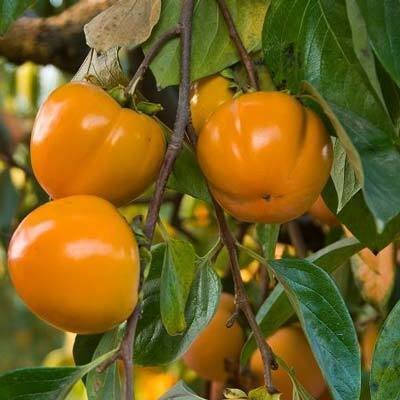
How to Care for Fuyu Persimmons: A Complete Growing Guide
Share
Fuyu persimmons (Diospyros kaki 'Fuyu') are a favorite among home gardeners for their sweet, seedless fruit and low-maintenance nature. Unlike astringent varieties, Fuyus can be eaten crisp like an apple or left to soften slightly. Whether you’re planting your first tree or nurturing a young one, this guide will walk you through everything you need to grow and enjoy delicious Fuyu persimmons year after year.
What Makes Fuyu Persimmons Special?
- Non-astringent: Sweet and edible when firm—no waiting for full ripening.
- Seedless: In most cases, Fuyus produce little to no seeds.
- Compact and Ornamental: Glossy foliage, beautiful fall color, and striking orange fruit.
- Cold-Hardy Zones: USDA Zones 7–10.
Where to Plant a Fuyu Persimmon Tree
Sunlight:
Fuyu persimmons need full sun, at least 6–8 hours of direct light per day. Sunlight ensures strong growth, proper flowering, and sweet fruit.
Soil:
- Well-draining soil is key.
- Slightly acidic to neutral pH (6.0–7.0).
- Tolerates sandy, loamy, or clay soils—as long as drainage is good.
Tip: If your soil holds too much water, plant on a slight mound or berm.
Spacing:
Space trees at least 15–20 feet apart to allow good air circulation and canopy spread.
Watering
- Young trees: Water deeply 1–2 times a week until established (first 1–2 years).
- Established trees: Drought-tolerant but produce best with regular watering.
- During fruit development (late summer into fall), maintain even moisture to prevent fruit drop.
Fertilizing
Fuyu persimmons are light feeders. Over-fertilizing can reduce fruiting and lead to excessive leaf growth.
- When to fertilize: Late winter or early spring, just before new growth begins.
- Use a balanced slow-release fertilizer like 18-5-10 Slow Release or compost-rich organic matter around the drip line.
- Avoid nitrogen-heavy fertilizers used for lawns near the root zone.
Pruning
- Prune in late winter while the tree is dormant.
- Remove crossing branches, water sprouts, and suckers.
- Thin the canopy slightly to let in light and improve airflow.
- Maintain an open-center or modified central leader shape for best fruit access and health.
Harvesting Fuyu Persimmons
- Harvest Time: October through December, depending on your region.
- How to tell they’re ready: Fuyu persimmons turn deep orange and feel firm—like a ripe tomato but not soft.
- Use clippers or gently twist fruit off with the calyx (leaf cap) attached.
Fuyus can ripen further off the tree if picked early. Store at room temperature for a few days to soften if desired.
Final Tips for Growing Fuyu Persimmons
- Self-pollinating—you only need one tree to produce fruit
- Little to no pest/disease issues
- Excellent for fresh eating, salads, drying, or baking
- Long-lived tree with increasing fruit yield year after year
